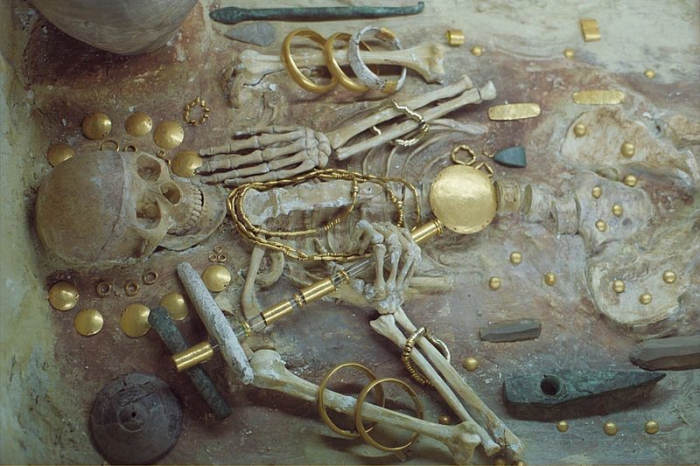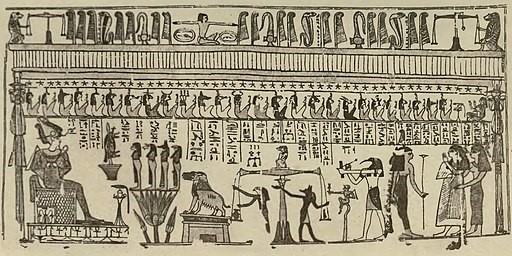

Burial, a well-known act of discarding human cadavers by burying them in the ground, in a grave or a tomb, or by dumping them in a body of water, exposing them to the weather, or feeding carrion-eating animals. Practices surrounding burial are influenced by geography, religion, and social structure. Whether the body is buried underground, submerged beneath water, burned, or exposed to the air depends on geography and climate. The level of burial ostentation is determined by social and religious beliefs; for instance, rank may determine whether the deceased is buried in a shallow trench or an impressively large and constructed underground chamber.

Burial with skeleton and gold treasure. Burial place near Varna. Chalcolithic, 4600-4200 BC. Varna Archaeological Museum.
Zde, CC BY-SA 4.0
Throughout Egypt's extraordinarily long history, ideas about the afterlife varied, but they were generally characterised as a heaven where people lived forever. For the Egyptians, their nation was the most ideal location that the gods had ever provided for human wellbeing.

The Sacred Books and Early Literature of the East
See page for author, CC0, via Wikimedia Commons
Thus, the afterlife was an exact replica of the life one had lived on earth, down to the minute detail, with the only difference being the disappearance of all the bad or sad parts of living. Inscriptions about the afterlife depict couples reuniting in paradise and engaging in all of their favourite activities, like walking by their favourite stream and sitting beneath their beloved sycamore trees or the things they carried out on Earth, such as cultivate the fields, gather the grain, eat, and drink. But one would need the similar things one had in life to live this bliss.
The most conventional and popular type of interment provided by cemeteries is burial, in which caskets or cremated remains are buried in the ground. The body of the departed is placed inside a coffin during a traditional in-ground burial. Following that, the coffin is lowered into a vault or other outer burial container within an excavation, where it is covered with dirt. An inscription on the burial monument, which is located above ground, includes the deceased's name, date of birth, and any extra epitaphs. The five standard elements of an in-ground burial are a coffin, a gravesite, a marker, a vault, and the opening and shutting of the grave.
An individual's cremated or casketed remains can be interred in a crypt or niche using the above-ground entombment burial option. Cremation niches are burial chambers that are roughly 12x12x12" in size. They can be standalone buildings or integrated components of larger mausoleums. Usually built of marble, granite, or glass, cremation niches can be used for either a single person or for companions. The urn and other personal items, like pictures, can be exhibited in niches with glass fronts. A person's personal details and epitaph may be written on a marble or granite crypt or niche.
It practises lessen the burial and memorialization negative effects on the environment. Natural burial, sometimes known as "green burial," is the practice of returning a deceased person's body to the earth so that it can gradually disintegrate in the soil and, in some situations, protect native and endangered wildlife. The foundation of the green burial movement has been a desire to live in harmony with nature and environmental awareness. In place of headstones, alternative coffins constructed of wicker, biodegradable materials, and other plants are being used, along with trees. Both methods offer enduring substitutes for traditional burials.
A wealthy person's tomb would contain items that are still valued today, such as elaborately created pieces of gold and silver, games made of beautiful wood and precious stone, bedding, chests, chairs, statues, and garments. However, the main function of burial goods was to give the deceased what they will need in the hereafter, not to flaunt their position. Therefore, a richer person's grave would contain more grave goods - of whatever that person preferred in life - than a poorer person's grave. Favourite meals like bread and cake were left in the grave, but regular food and drink contributions were expected from the deceased's relatives.
The soul would initially feel imprisoned and bewildered when a person's body ultimately failed them. Rituals of Mummification prepare the spirit for the journey from life to death, but the spirit couldn't pass away until the right funeral rituals were observed. The soul would be completely unaware of its location and what had transpired when it awoke in the tomb and ascended from its body. The Pyramid Texts and subsequently the Coffin Texts were transcribed and drawn inside the tombs to reassure and direct the departed souls when their arise inside the dead body.
Although they weren't always buried with their owners, pets occasionally had their own tombs. If one had enough wealth, they might have their pet baboon, cat, dog, gazelle, bird, or fish mummified and buried with them. The High Priestess Maatkare Mutemhat, who was buried with her mummified pet monkey, and Queen Isiemkheb, who was buried with her pet gazelle, are the two best examples of this.
Burying is the process of placing the dead body of a person inside a tomb or a grave which is dug in the ground.
The process of burying is dead involves putting the body of a deceased person in a tomb created for that purpose or in a grave dug in the ground. In societies such as Mesopotamia, tombs and graves were dug beneath the earth with the hope that the soul of the deceased person would able to enter the afterlife easily, which was believed to exist below. In ancient societies, graves were typically marked with a stone engraved with the deceased's name and likeness or by a lavish tomb (like the Egyptian pyramids)
Q1. What are water burials?
Ans: Numerous civilizations' myths, which frequently centre on a god-hero who departs from his people in death with the promise of returning, reflect the relationship between water and immortality. Consequently, death ships have frequently been used to cast chiefs' and heroes' bodies off the coast of rivers and seas. It consisted just of loading the deceased into a canoe and propelling it out to sea.
Q2. What are the key benefits of above-ground entombment?
Ans: The knowledge that the coffin or urn is kept secure, tidy, and dry is one of the main benefits of above-ground entombment. The majority of crypts are covered with the outer shield face after being sealed with a metal inner wall, glue, or caulk. If the crypt or niche is located indoors or if the family has a private crypt, visitation may be simpler. Families can get in touch with their neighbourhood cemetery to find out if above-ground entombment suits their requirements.
Q3. Explain Shabti dolls
Ans: In ancient Egypt, shabti dolls (often known as ushabti) were mortuary statues that followed the deceased to the afterlife. The Egyptian word for stick, swb, also corresponds to the word for "answer" (wsb), and as a result, the shabtis were known as "The Answers."
Q4. Discuss exposure
Ans: For both spiritual and practical reasons, many societies have believed that burying the body where it can be eaten by scavenger animals or worn down to its basic components is the best option. This method of burial, which originated from the notion that the corpse is so filthy that to inter it or burn it would taint the "pure elements" of earth, fire, and water, has likely been practised by the Zoroastrians the most.